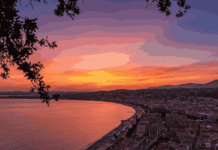
You land at the sun-drenched airstrip of Sorong, the gateway to the remote and wonder-packed archipelago of Raja Ampat (literally “Four Kings”). In less than a day’s travel, you’ll be swapping airport buzz for emerald waters, limestone karsts rising from turquoise seas, and perhaps a curious village dog sniffing at your sandals on the pier.
If you’re reading this, it’s because you’re after more than pretty photos; you want to dive into the islands and the marine life of Raja Ampat, with its head-spinning biodiversity and raw beauty. This is your guide to doing just that: how to get there, what to see, how to behave, and how to maximize every moment without falling into tourist trap clichés.
Getting There and Getting Set Up
To reach Raja Ampat, you will typically fly into Sorong, then take a ferry or boat onward to your destination. From here, you have two major styles of exploration: land-based resorts or a full-on live-aboard. If you’re considering a specialized journey, Raja Ampat yacht charter allows you to float between islands at your own rhythm, waking each morning in a new bay.
Practicalities:
- Arrival via Sorong airport (via Jakarta, Makassar, or Manado)
- Ferry/boat from Sorong to Waisai/Waigeo (~2 hrs) or longer for more remote areas
- Choose stay-type: resort, homesta,y or yacht charter
- Pack reef-safe sunscreen and maybe a rash guard: the marine life here is fragile.
Did you know? The archipelago consists of over 1,500 islands, islets, and coral shoals around the four main ones: Waigeo, Batanta, Salawat, and Misool.
The Islands and Their Characters
Each of the major islands has its own vibe. Think of it as siblings: same bloodline, different personalities.
| Island | Vibe | Key highlights | Travel tip |
| Waigeo | Lush, accessible, social | Bird-of-Paradise viewing, clear shallow bays | Good first stop, less intense than remote sites |
| Batanta & Salawati | Slightly wilder, forested | Mangroves, green beaches, fewer crowds | Remoteness adds cost/time |
| Misool | Remote, high-end, dramatic | Kaleidoscopic reefs, quiet bays | Best reached by live-aboard for full effect |
Marine Life: The Whole Shebang

Here’s where things get serious. Under the surface of Raja Ampat lie reef ecosystems that many say are the richest on earth.
According to marine biologists, there are upwards of 1,500 species of fish, 550+ species of hard and soft corals, and at least 17 species of marine mammals recorded in this region.
You’ll be in good hands if you keep your eyes open and your ego away from the camera lens for a second. Expect:
- Giant manta rays gliding like ancient birds above coral plateaus
- Pygmy seahorses, the size of your thumbnail, are clinging to sea fans
- Sharks (reef, wobbegong, even whale sharks) cruising silently in the blue
Bonus tip: Bring both wide-angle and macro underwater gear (or at least ask your operator). The variety is jaw-dropping. On one dive, I saw a manta, a pygmy sea-horse, and a reef shark all before my regulator screamed “air low”.
Best Snorkeling and Diving Spots
You don’t have to be a dive pro to fall hard for Raja Ampat – snorkelers have plenty of reasons to grin ear-to-ear, too.
Narrative section: I strapped on a mask, flopped into the warm, glassy water off Kri Island, and fifteen minutes in, I found myself among a swirling school of fusiliers the size of football teams, darting around coral bommies like kids at a festival.
Key spots:
- Cape Kri – famous for its sheer number of fish species in one dive.
- Melissa’s Garden – soft corals, gentle slopes, great for both diving and snorkeling.
- Aljui Bay – nudibranch heaven, shallow reefs, superb for macro photography.
Quick checklist for selection: - Currents can be strong – choose an appropriate level
- Visibility is typically 25-30m, but varies.
- Snorkeling sites may be closer to shore; diving expeditions often need boat time
Responsible Travel: Because It Matters
When a place is this beautiful, it’s easy to forget you’re entering someone else’s world — and an ecosystem that doesn’t owe you anything. The waters around Raja Ampat are part of the protected “Bird’s Head Seascape,” around 4.5 million hectares.
“The Indonesian Throughflow brings nutrients from the Pacific, nurturing one of the richest marine ecosystems on Earth.”
What you can do:
- Use reef-safe sunscreen (oxybenzone and octinoxate chemicals damage coral)
- Avoid touching coral or standing on reefs (yes, I’ve seen tourists do it)
- Support local operators who hire locals, respect villages, and pay community fees
- Consider your travel footprint: fewer flights, slower stays, more connections
- Respect cultural norms: ask permission before photographing villagers, be mindful of attitudes
Small gesture: one morning, I helped pull a fishing net from a shallow reef with a local guide, who said it happens often and even helped save a turtle. Worth a few minutes’ labor.
When To Go, Where To Stay, and How Long

Raja Ampat can be visited year-round, but if you want the clearest skies and calmest sea, go between October and April. That said, the weather doesn’t wait for your schedule, so pack flexibly.
Accommodation styles:
- Homestays: cheapest, very local, basic amenities
- Resorts: mid to high end, more comfort, dive facilities
- Yacht charter/live-aboard: premium, mobility, remote access
Recommended time: Minimum 7-10 nights if you want to explore at a relaxed pace. Less than that and you’ll feel like you’re just skimming the surface.
Budget tip: Remote location = higher costs. Booking in advance, combining travel with fewer island hops, and choosing simpler stays can save thousands.
Tiny caution: Ask your accommodation what happens if rough seas delay the ferry back to Sorong – better safe than stuck.
Wrapping Up: Why This Trip Will Change You
You’ll walk off the boat with salt in your hair, sand in your camera, and the kind of sunset in your mind that won’t fade. But more than that, you’ll carry something deeper: a reminder that the world still holds places where life bursts in full color under the waves and silence above.
In the end, whether you’re gliding over coral gardens, watching a manta flap past like a slow-motion bird, or sipping coconut from a beach shack with a curious local dog at your feet, you’ll remember one thing: you came to somewhere, not merely for something.
Go slow and let yourself get lost just a little.



